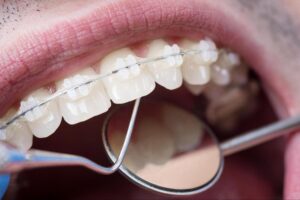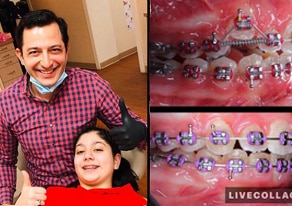A straight smile isn’t just about appearance—it’s about comfort and long-term dental health. Many people live with crowding, gaps, or bite problems without realizing they point to deeper alignment issues. Small signs like uneven wear on teeth or difficulty chewing can signal it’s time to see an orthodontist.
Here are the 10 Common Signs to Watch For
By learning the most common signs you need braces, you can catch these issues early and prevent future complications. From crooked teeth to jaw pain, each sign reveals something about how your teeth and bite are working together. Understanding these early patterns helps you make informed decisions about improving your smile and protecting your oral health.
 1. Crowded or Overlapping Teeth
1. Crowded or Overlapping Teeth
Crowded teeth are one of the clearest early signs of needing braces. When teeth overlap or twist, it becomes harder to clean them properly. Plaque can build up in tight spaces, increasing the risk of cavities and gum inflammation.
An orthodontic evaluation for crooked teeth can help determine how much crowding exists and what treatment will align your smile. Correcting this issue early not only improves appearance but also prevents future dental problems.
Addressing crowding as soon as possible supports better brushing and flossing habits. It also ensures your bite stays balanced, which is essential for long-term comfort and oral health.
2. Large Gaps Between Teeth
Spaces between teeth might seem like a small concern, but they can affect more than your smile’s appearance. Gaps allow food to get trapped and make gums more vulnerable to irritation or infection. Some people also find that spacing impacts how they bite and chew.
These openings can appear from genetics, missing teeth, or jaw growth patterns. Over time, they may widen or shift, creating uneven pressure on certain teeth. Correcting spacing keeps your teeth properly aligned and prevents damage caused by uneven force.
Recognizing large gaps as one of the common signs you need braces helps you take action before the spacing becomes more noticeable. Orthodontic treatment can close these gaps smoothly and give your smile a more balanced, natural look.
3. Frequent Biting of the Cheeks or Tongue
If you often bite your cheeks or tongue while talking or eating, your teeth alignment might be off. This happens when your bite doesn’t close evenly, causing certain teeth to interfere with natural movement.
Over time, this can lead to mouth sores, irritation, and even changes in how you chew. Braces can realign your bite so your teeth fit together properly, reducing the chance of accidental bites.
Paying attention to this habit early can help you prevent chronic discomfort and protect your mouth from unnecessary irritation.
4. Difficulty Biting or Chewing Food
Struggling to bite into or chew certain foods is a strong indicator that your bite may be uneven. When teeth don’t meet correctly, you may feel pressure on specific areas or find chewing tiring.
This imbalance can affect digestion since food isn’t broken down as effectively. It may also cause certain teeth to wear faster than others.
Braces can correct this misalignment, making everyday activities like eating more comfortable and efficient.
5. Speech Problems or Lisping
Speech issues can develop when teeth or jaw alignment interfere with tongue placement. Lisping, slurring, or difficulty pronouncing certain sounds are often linked to gaps or crowding.
Correcting alignment through orthodontic treatment helps improve clarity and confidence when speaking. Many patients notice better speech once their teeth are properly aligned.
This improvement is often one of the most rewarding outcomes of treatment, enhancing both communication and self-esteem.
6. Mouth Breathing or Jaw Pain
Persistent mouth breathing, especially during sleep, may indicate jaw alignment issues. This can also lead to dry mouth, which increases the risk of decay and bad breath.
Jaw discomfort or tightness while chewing may signal that your bite places uneven stress on muscles and joints. Over time, this can cause headaches or soreness near the ears.
Braces help align your jaw correctly, relieving tension and promoting better airflow during rest.
7. Uneven Wear on Teeth
When teeth don’t align properly, some areas bear more pressure than others. This leads to uneven wear, chipping, or flattening on specific teeth.
These small changes often go unnoticed at first but can worsen over time, affecting how your smile looks and functions.
Orthodontic care helps distribute pressure evenly, preserving your enamel and protecting your teeth from future damage.
8. Protruding Front Teeth
Front teeth that stick out are not just a cosmetic issue—they’re more likely to chip or get injured. Protrusion often results from an overbite or underbite that shifts the upper or lower jaw forward.
This imbalance can make closing your mouth or chewing uncomfortable. Orthodontic treatment corrects the alignment, protecting your teeth and improving facial balance.
It’s one of the clearest symptoms of dental misalignment that braces can effectively fix.
9. Early or Late Loss of Baby Teeth
Losing baby teeth too early or too late can affect how adult teeth come in. This timing issue can cause crowding or spacing problems that lead to misalignment.
Early signs of needing braces often start here, especially for children who show noticeable shifting or uneven growth.
A professional evaluation helps determine if early intervention is needed to guide proper development.
10. Jaw Shifting or Clicking Sounds
Hearing a click or pop when opening your mouth can point to jaw misalignment. This might also come with stiffness or soreness in the jaw area.
When the upper and lower jaws don’t align correctly, it affects how you bite and chew. Over time, this can cause discomfort and wear on the joints.
Braces help restore balance between the jaws, improving function and reducing strain during everyday movements.
Common Questions About Braces
 How long does it take to see results from braces?
How long does it take to see results from braces?
Most patients begin noticing small changes within a few months, though complete treatment can take one to two years, depending on the case.
Do braces hurt?
You may feel mild soreness for a few days after adjustments, but it usually fades quickly. Over-the-counter pain relief and soft foods can help ease discomfort.
Are clear aligners as effective as braces?
Yes, for many mild to moderate alignment issues. Your orthodontist can recommend the best option based on your bite and treatment goals.
Can adults still get braces?
Absolutely. Orthodontic care works at any age, and many adults choose braces or Invisalign to improve their bite and appearance.
How do I keep my teeth clean while wearing braces?
Brush after meals, use floss threaders or a water flosser, and rinse with fluoride mouthwash to protect enamel and prevent buildup.
Get to Know Halabi Orthodontics in Brooklyn, NY
At Halabi Orthodontics, smiles are personal. Dr. Eli Halabi and his skilled team create confident, healthy smiles through advanced orthodontic care in Brooklyn, NY. Patients of all ages trust their expertise in braces, Invisalign, and modern treatment options designed for comfort and precision.
With a passion for detail and state-of-the-art technology, the practice delivers care that makes every visit positive and productive.
If you’re experiencing any of the common signs you need braces, schedule your consultation with Halabi Orthodontics today and start moving toward a smile that feels as good as it looks.

 CURRENT PATIENT NUMBER
CURRENT PATIENT NUMBER

 What patients are saying
What patients are saying Your smile our passion
Your smile our passion News and Events
News and Events